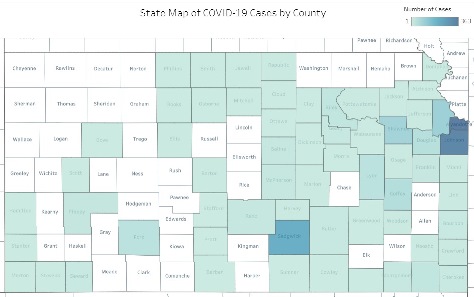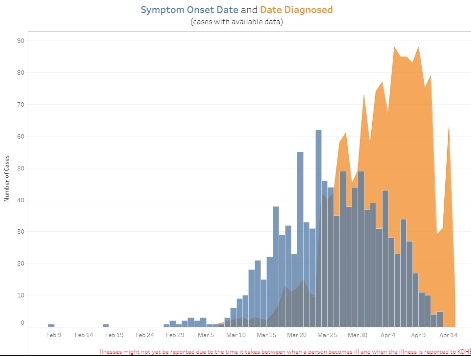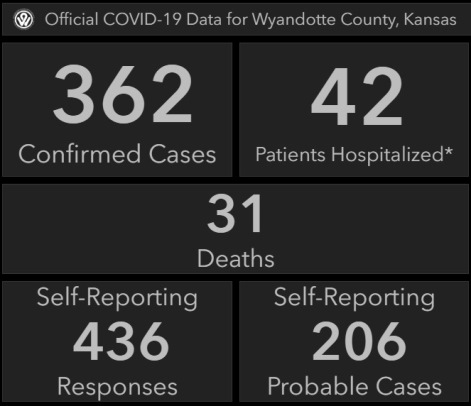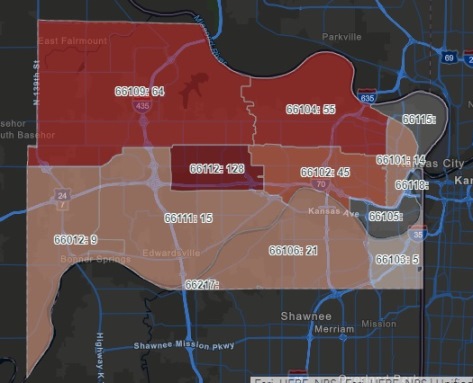

Gov. Laura Kelly today extended the stay-at-home order until May 3, while Kansas reported seven more COVID-19 deaths and 68 new cases statewide.
Kansas now has 1,494 confirmed positive COVID-19 cases and a total of 76 deaths, Gov. Kelly said. Sixty-three of the 105 counties have positive cases.
The state’s stay-at-home order originally was in place through April 19.
Gov. Kelly said cases continue to increase, and COVID-19 is spreading into more counties. Internal and external models predict a peak between April 19 and 29, she said.
“Ideally we would like to see a reduction in the number of cases for 14 days before we begin to relax social gathering restrictions,” Gov. Kelly said at a news conference Wednesday.
Between now and May 3, the governor said she would consult with business leaders, health experts economic leaders and other leaders to determine the best path forward so that the state can reopen the economy safely and effectively.
She said she was working with Missouri’s governor as well as with the mayors of cities in the Kansas City area in a regional approach to reduce confusion and help keep communities safe. In addition, she has begun conversations with Colorado’s governor to coordinate efforts that will affect western Kansas.
Gov. Kelly said the state is highly focused on expanding its testing capacity during the next two weeks, so that rapid testing, contact tracing and isolation efforts can be used to prevent local spread and not overwhelm health care facilities.
“It’s true that no state in the nation will truly be able to get back to normal until a vaccine for COVID-19 is developed, manufactured and made widely available,” Gov. Kelly said.
She said they will not be able to lift all restrictions on mass gatherings overnight, but they know how much of a hardship the mitigation efforts have caused for thousands of families and businesses.
“We’re working as quickly as we can to give our communities a plan for the future,” Gov. Kelly said.
Gov. Kelly had received a letter from 40 state legislators asking her to reopen the state.
Since the start, she said she has been aware that at some point they will need to reopen the economy, reopen the schools next fall, reopen businesses and reopen manufacturing, she said.
She said she participated in a phone clal with other governors, and has asked the governors’ association to consolidate all the best practices for reopening from throughout the nation, to serve as a resource.
She said Kansas would reopen “as soon and as safely as we can, so we don’t put people’s lives in danger.”
The governor also said reopening may look different in different counties, and that a rural county’s reopening may be different from Wyandotte County. The local health departments will be able to extend stay-at-home orders once the state order is lifted.
Until they have a vaccine, there will have to be safety and security measures in place, she said. The experts have talked about a year to a year-and-a-half for a vaccine. Gov. Kelly said there will be public health experts at the table in deciding on when and how to lift the stay-at-home order.
“If we don’t do this right, we will do more damage to the economy than you can imagine,” GOv. Kelly said.
She said during the 1918 Spanish flu pandemic, two cities next to each other, St. Paul and Minnesapolis, Minnesota, took different approaches to reopening. While St. Paul opened up quickly, Minneapolits took more time, reopening more cautiously.
Long after it was over, she said, Minneapolis was far ahead of St. Paul because they did it right, “and that’s what we need to do.”
If they rush opening up again, they will end up doing more harm, she said.
“If we take it slowly, cautiously, we will win that race and be better off in the long run,” Gov. Kelly said.
Dr. Lee Norman, Kansas secretary of health, said Kansas currently is monitoring 26 outbreaks, including 12 in long-term care facilities, two in group living situations, five outbreaks in private companies, one in a correctional facility in Lansing, one in a hospital and five religious gatherings.
At Lansing Correctional Facility there are 44 cases, including 24 staff members and 20 inmates, Dr. Norman said.
While serology testing may be somewhat helpful, Dr. Norman said the Kansas Department of Health and Environment today would send out a health action alert on it to providers today.
“We need to use caution with the use of serology testing at this time,” he said.
A new policy from the Food and Drug Adminsitration allows manufacturers to sell serology kits; however, the test are not FDA-approved, he said.
The FDA has stated these tests are not to be the sole basis to diagnose, and a negative result does not rule out COVID-19, he said. That can be problematic as people want to sue negative serologic test results to say they don’t have COVID-19, but non-FDA approved tests have a very high false negative rate and are not validated by the FDA, Dr. Norman said.
He added that serologies are used to improve diagnoses of infection when combined with molecular tests, including the test that uses a sample from the nose.
Those tests, which required long swabs that were scarce earlier this week, now will be ramped up because of an overwhelming response from dentists, Dr. Norman said. Some dentists are producing the non-natural swabs using equipment they had.
Expanded testing will begin on Thursday in Sedgwick and Thomas counties, with Finney County starting Monday, he said. Expanded testing already is taking place in Wyandotte, Johnson and Leavenworth counties, he said.
The KDHE also is finishing a training module and will bring on 400 volunteer contact tracers to help trace contacts of persons who have tested positive for COVID-19, he said.
Dr. Norman said Kansas has a fairly low death rate per capita compared to other states.
State Department of Labor website
Gov. Kelly also reported that as of today, nearly 150 state employees are answering the phone and trying to assist Kansans who are applying for unemployment benefits at the Kansas Department of Labor.
The state started with 20 employees, she said. The demand remains at historic highs, and on Tuesday alone, the call center received 751,940 calls, she said. She urged anyone who called not to hang up, as it would puot them at the end of the line again and increase wait times.
Also, the state has a team of 30 persons working around the clock to increase website capacity for the Department of Labor and address bugs in the website, she said. The website was down briefly on Tuesday for work. The website received an average of 600 claims pre-pandemic compared to 14,000 claims a day after the pandemic, she said. They have just processed 4,108 initial claims, with 42,895 continued claims processed on Tuesday, a significant jump in capacity, she added.
To see the governor’s news conference, visit https://www.facebook.com/GovLauraKelly/.
The Kansas COVID-19 resource page is at https://govstatus.egov.com/coronavirus.
The UG’s COVID-19 webpage is at https://alpha.wycokck.org/Coronavirus-COVID-19-Information
The CDC COVID-19 page is at https://www.cdc.gov/coronavirus/2019-nCoV/index.html



